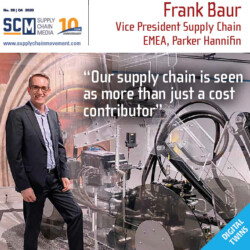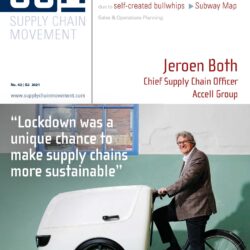Supply Chain Movement 55 | Transformation

The main theme of the 55th issue (Q4, 2024) of the quarterly magazine Supply Chain Movement is Transformation.
Publication Date: November 29, 2024
12 | Profile John Tros, Senior Vice President Operations, BME
The more volatile the market, the higher the demands placed on wholesalers. This is especially true for building materials. In construction, various circumstances make forecasting difficult. Issues such as transport costs as well as national laws and regulations add to the complexity. Managing that complexity is the core task of John Tros, who is responsible for operations at Building Materials Europe (BME). “I love getting the most out of what we have, every day.”
19 | Checklist for supply chain traceability
Environmental, social and governance (ESG) issues are increasingly stringent, redefining the paradigms of supply chain models: from the relationships with suppliers, to the engagement of the end customers. Manufacturing, wholesale and retail companies are in need of traceability along the entire supply chain, from sourcing and supplier selection to after-sales.
21 | Supply chain transformation requires clear strategic vision
Companies with mature supply chains are continuing to transform without hesitation. But companies that have failed to invest in their supply chain for years are struggling. They understand that transformation is necessary, but where should they start? And in which direction should they steer their organization? Four participants in the E2E Supply Chain Ecosystem Transformation Survey share their experiences.
26 | Mindmap supply chain resilience
With the increasing frequency of global challenges – whether they be natural disasters, pandemics, or geopolitical tensions – the importance of a resilient supply chain has never been greater. Together with supply chain consultancy Involvation, Supply Chain Movement has developed a mindmap for supply chain resilience. This mindmap visualizes the megatrends in global business, their impact on business functions, the challenges in supply chains, and the necessary capabilities to gain resilience.
30 | 10th edition of Top 28 Supply Chain Executives in Europe
Due to the current uncertain times, with many ongoing geopolitical conflicts and others looming, European companies need to transform their supply chain networks to become more resilient, agile and competitve. Supply chain executives struggle with ‘selling’ these transformations in the boardroom. This is evident from the research and series of interviews for the annual Top 28 Supply Chain Executives Europe by Supply Chain Media, IG&H Consulting and Inspired-Search.
36 | FMCG companies have been buffering stock to keep profitability stable
Despite many challenges facing FMCG companies, the 20 largest European FMCG companies have been able to keep profitability stable. They have done so by increasing both their prices and their stock positions – the first to counter rising inflation, the second to defeat the many supply chain issues. However, FMCG executives need to be careful because both mechanisms will not work year after year – as can be seen by looking at the 20 largest global FMCG companies.
39 | Roadmap for value chain transformation
In today’s business landscape, companies are under increasing pressure to adapt their value chains to remain competitive. Value chain transformation involves rethinking and redesigning the way an organization creates, delivers and captures value. To navigate this complex process successfully, a structured roadmap is essential. This blueprint by Efeso management consultants and Supply Chain Movement outlines a five-step roadmap that shall guide companies through a succesful value chain transformation.
43 | Next step: from control tower to command centre
Despite the turbulence in supply chains, the adoption of end-to-end supply chain visibility lags behind expectations. To find out more, consulting firm BCI Global and Supply Chain Media surveyed 123 supply chain executives about their motivations and challenges. What emerged? The vast majority really do need end-to-end visibility, and would ideally like to take things even further.
52 | Checklist for dock and yard management
Dock and yard delays caused by inefficient manual systems generate unwelcome costs. What’s even more worrying is that many of those costs are invisible at first glance, but still affect the bottom line. With margins shrinking in these uncertain times, a serious competitive advantage is now achievable for businesses who embrace the opportunities of dock and yard management solutions.
Want to read more?
Subscribe now to the quarterly magazine of Supply Chain Movement >>










